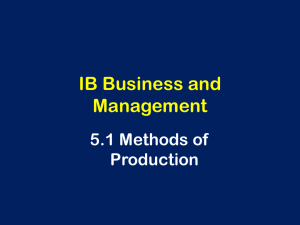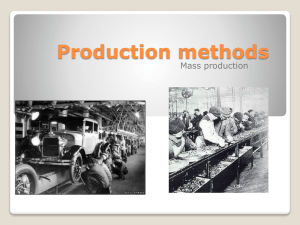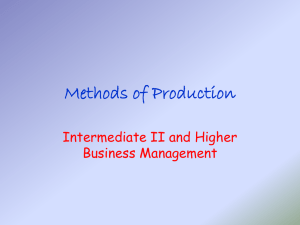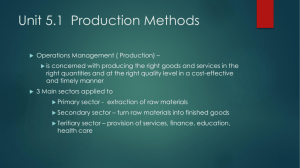Production - AIS-IB
advertisement
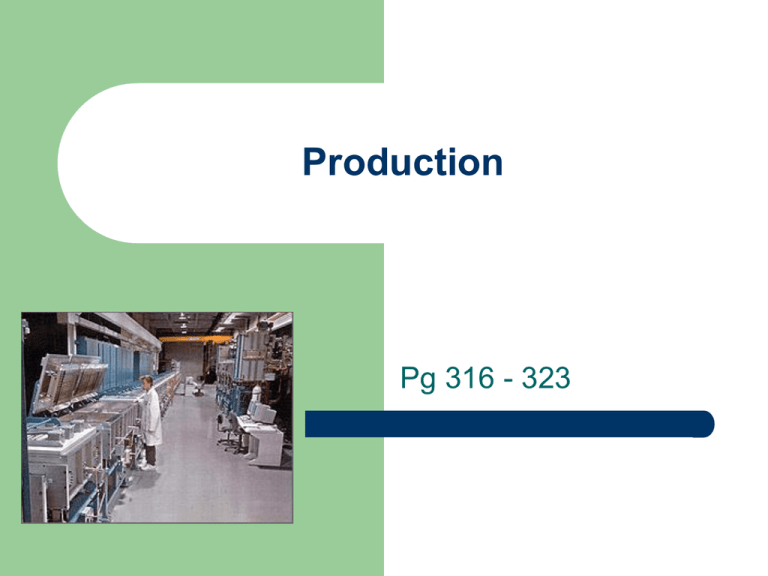
Production Pg 316 - 323 Production • • • • • Describe and compare the features and applications of job, batch, line, flow and mass production Analyse the most appropriate method for a given situation (HL) Understand the need for more than one Method (HL) Analyse the implications for functional areas (marketing, human resource management and finance) that arise from changing the production system. (HL) A3 Revision Sheets 4 Sheets 1 extra for HL • Describe and compare the features and applications Production is the process of converting raw materials or components into finished goods. The four factors to production are…….. ‘Remember?’ Four factors to production Land Labour Capital Enterprise … they combine in different proportion as inputs to the production process Production Mash up: http://www.youtube.com/watch?v=DTWnQD Ahp9k Some goods and services produced use a high proportion of labour (staff).. Labour intensive - this is where the proportion of labour used in producing the product is relatively high. Labour will usually be used instead of capital. Other goods produced use a high propotion of machinery…. Capital intensive - this is where techniques are used to produce that use relatively more capital than labour. Many industries are now like this including the car and steel industries. Labour or capital internsive? The technique that a company uses depends on several things: the size of the company - small companies are often not in a position to afford expensive capital equipment. Even if they could they are often not able to use it enough to justify the cost. the cost of the factors of production - even though a machine may be available to do the job, it may not be worthwhile if the amount of labour required costs less. Firms therefore look carefully at the cost of labour and capital before deciding how much to use. the product - some products lend themselves better to being produced by capital than others. Mass-produced everyday items are far more likely to be produced in a capital-intensive way, whereas services and products with a more individual slant are more likely to be produced using a large proportion of labour. Developing countries tend to be more labour intensive.. Developing countries more capital intensive. METHODS OF PRODUCTION Three main methods of production are used… The choice of method depends largely on the type of product. Summary: http://www.youtube.com/watch?v=CLPFG5QCx0g Job production - this is a method of production where companies use all their factors of production to complete one job at a time. This will usually happen where products are all unique or they are being produced on a very small scale. Batch production - this is a method of production where one operation is completed on a number of units of the product, before they are then passed on to the next stage of the process. Flow/Mass production - this is where production takes place as a continuous process. The product flows from one process onto the next. This will usually happen where the product is standardised, and can be made using a production line method. Job Production Individual, unique process Unique design based on customer specification If made in a factory, the business would need to retool each time! Require a highly skilled labour and a high labour-to-capital ratio Labour intensive Expensive Take a long time Examples: Ships, bridges and hand made crafts such as furniture making and made-to measure clothes Job Production Cell 1 Finished Product Cell 2 Finished Product Cell 3 Finished Product One off production, each product could be different Mass (flow) Production Opposite of Job production. ‘the process of large quantities of identical products often on assembly lines’ All products are identical, and the aim is to make as many as possible. To be efficient production is continuous with no stoppage Many mass productions open 24 hours and staff work on shifts. The aim is economies of scale and so produce at minimum cost. Mass production is highly capital intensive – it costs a lot to buy the capital but it is cheap to run it afterwards. Modern mass production use robots, not people to do most the work. 2 Flow Production Operation 1 3 4 5 6 7 Finished Product 11 10 9 Mass market products that are identical 8 Mass Production It is used Mass markets products. Modern consumer goods are produced this way e.g. chocolate bars, person stereos and toaster. Production line – where the workers and machines stay at the same point allows them to specialise. Mass production is sometimes called continuous flow production. Problems with Mass Productions Production line and process meant that the product was travelling long distances within the factory. (time and size increases cost) Large volume of stock kept. Communication poor (people like robots) Workers not responsible for quality Production inflexible (poor skill) Batch Production Is a mixture of the two Business use mass production techniques to make a Batch of the thing and then stop, reorganise, and make a batch of something else. Small groups of products made in stages It is suited to products that are identical to each other, but are only produced in limited quantities – or for a limited amount of time. 1b Batch1aProduction 2a Operation 1 3a 3b 1c 2b 3c 1d 2c 3d Products made one batch at a time to allow modifications on some items 4 Examples.. A specific process for each item takes place at the same time on a batch of items, and that group does not move onto the next stage of production or inspection until the whole batch is done. For example, in small bakeries and many homes, as opposed to large food manufacturing companies, cookies are baked in batches. A baker must first make the dough, then place it onto baking sheets, and then bake it. People are limited as to how many cookies they can produce at one time by the number of baking sheets and ovens they possess, and by the size of bowls available to mix each batch. This is batch production, since a large number of cookies is baked at the same time, and bakers can’t skip from one step to the next until each process is complete. They can’t start cooking the cookies until they've made the dough, and they can’t remove the cookies from the oven (in most cases) until all the cookies are done, unless using an oven with a conveyor belt. There are necessary steps that apply to the whole batch of cookies. Cooking may requires a baker to bake in individual batches, increasing the final time between finishing the dough and actually having completed baking all the cookies. Example… Another example is found in thin film coating of materials, like lenses, computer screens and the like. A coating machine can hold a finite number of the item being produced, and it can take several hours to over a day to apply the coatings needed in order to produce one batch. After materials are coated, they move on to the inspection process, while the coating machine must be readied for the next batch. This resetting of the machine may take considerable time, and may require several steps before the next batch can be placed in the machine. Batch or flow? http://www.youtube.com/watch?v=GUkO0M7ed ok Cell Production (HL) Cell production is a form of flow production, but instead of each worker performing a single task, the production line is split into several selfcontained, mini-production units - known as cells. Each individual cell produces a complete unit of work, such as a complete washing machine motor and not just a small part of it. Each cell has a team leader and below that a single level of hierarchy made up of multi-skilled workers. The performance of each cell is measured against preset targets (output levels, quality and lead times, etc). Cells are responsible for the quality of their own complete units of work (total quality management - topic 5.3, job enrichment and teamworking - topic 2.5). Cell Production (HL) The cell production method has led to: increased worker commitment and motivation job rotation within the cell increased productivity Improved productivity Fewer workers needed to produce the same as before, Fewer machines are needed, less factory space is required. This can then lead to DOWNSIZING of a business. Factories are closed and workers are made redundant. On the other hand, a business may find by lowering its prices demand increases. The same number of workers and factories can now produce more. Downsizing – reducing the number of inputs to the production process (workforce/factories) without necessarily reducing the output of the business. ACTIVITY SNOWBOARDS: http://www.youtube.com/ watch?v=sxZ-zLUe4T4 Handout • Analyse the most appropriate method for a given situation (HL) • Understand the need for more than one • Method (HL) • Analyse the implications for functional areas (marketing, human resource management and finance) that arise from changing the production system. (HL) How are they produced? In your book write down how you think each of these is produced…
